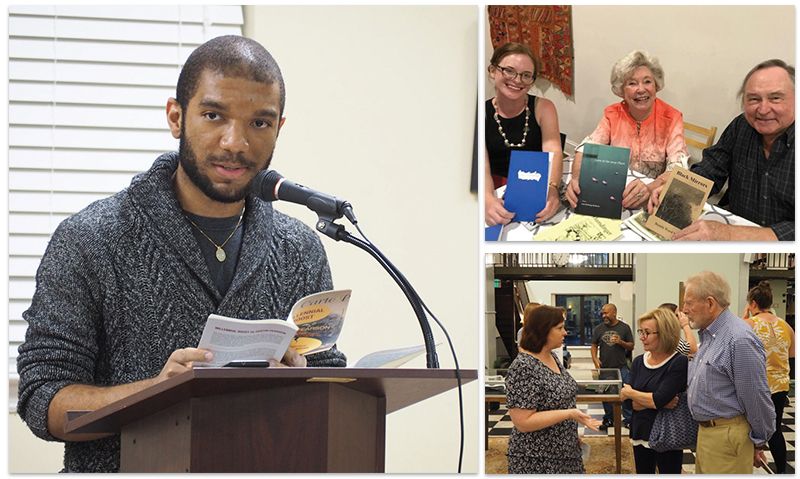The group prepares to celebrate its 100th birthday

(Clockwise from left) Poet Dustin Pearson reads from his debut collection, Millennial Roost, at a Poetry Society event last fall; Poets share their work during the inaugural Free Verse Poetry Festival; Poetry Society members Lisa Hase-Jackson, Judith Gordon, and Eugene Platt mingle during a reception for poet Christina Olson in October.
Poets would argue that the time is always right for poetry, and given the tumult of recent months, many non-poets readily concur. In times of ecstasy as well as pain, we are soothed by the rhythm of artfully chosen words, stirred by poetic images or phrases that tap into something deep and unbidden. Poems are like Charleston’s hidden alleyways—they offer glimpses into life’s mysteries, leading us to tucked-away wonder. So it’s no surprise that the city has long been a poet’s paradise.
This year marks the centennial of the Poetry Society of South Carolina (PSSC), which incorporated in 1920 during what became known as the “Charleston Renaissance”—a post-war, pre-Depression era when visual artists, playwrights, musicians, novelists, and poets were coming out of the splintered woodwork. The society got its start when John Bennett, Charleston’s best-known published writer and poet at the time, began holding Wednesday night critquing sessions with DuBose Heyward and later with Hervey Allen, according to PSSC’s president Jim Lundy, who is writing a book about the organization’s history.
That men’s group eventually joined with a similar group of women writers led by Laura Bragg, and in October 1920, legal documents were drawn up establishing the Poetry Society of South Carolina, with their first official meeting to follow in January 1921. “It was a fancy black-tie affair held at Society Hall, where our centennial gala—minus the black tie—will be held this January, 100 years to the month,” says Lundy. The 2021 gala will feature poet Terrence Hayes, a South Carolina native, MacArthur Fellow, former poetry editor for The New York Times Magazine, and National Book Award finalist.
Poems are like Charleston’s hidden alleyways—they offer glimpses into life’s mysteries, leading us to tucked-away wonder.
According to Lundy, the Poetry Society has been active since that initial meeting, including hosting Carl Sandburg at its second gathering, though some periods, such as the 1930s Depression-era, saw less activity. This longevity distinguishes them as the oldest state poetry society in the nation. Membership has held strong, with between 120 and 150 dues-paying members most years and a larger audience who attend PSSC readings, workshops, and events.
Though the majority of PSSC programming is hosted in Charleston, the nonprofit “fosters the craft of poetry” statewide. It sponsors 22 annual poetry contests as well as readings, seminars, and workshops featuring visiting poets, many of national renown. In the spring, PSSC members usually curate the Sundown Poetry Series, an annual literary highlight of Piccolo Spoleto Festival.
“I would say that for most of the society’s existence the focus was more ‘society’ and less poetry. That has been somewhat reversed in the 21st century,” says Lundy, who credits that change to the late Susan Laughter Meyers, a former PSSC president and long-term board member.
“When describing art of the highest order, we call it poetic,” says PSSC member Katherine Williams. “It’s a good idea to engage with poetry if you want to nurture a vigorous and diverse creative community.”